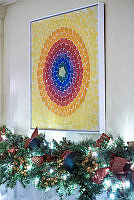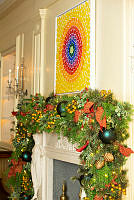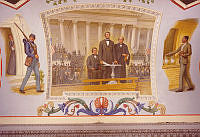Rubenstein Center Scholarship
Diversity in White House Art: Jacob Lawrence
My pictures express my life and experiences. I paint the things I know about and the things I have experienced. The things I have experienced extend into my national, racial, and class group. So I paint the American scene.
Jacob Lawrence, one of the twentieth century’s most celebrated Black artists, is remembered for his vivid portrayals of the Black experience in America. Lawrence was born in New Jersey on September 7, 1917, and raised in Philadelphia, Pennsylvania, and Harlem, New York. While taking art classes at Harlem’s Utopia Children’s Center and Harlem Art Workshop, Lawrence trained under prominent leaders of the Harlem Renaissance, including painter Charles Alston and sculptor Augusta Savage.1 Surrounded by a vibrant, flourishing community of Black artists in the 1920s, Lawrence explored his own identity through art.
In his early twenties, Lawrence rose in prominence as a painter while working for the Works Progress Administration (WPA)—a New Deal agency created by President Franklin D. Roosevelt that sponsored and employed many American artists during the Great Depression. Lawrence’s most renowned work, titled The Migration Series, was completed in 1941, when he was only twenty-three years old. The series consisted of sixty panels that depicted the triumphs and hardships of the Great Migration—a mass movement of Black migrants from the American South to northern urban centers in the early twentieth century.2 Lawrence had a personal connection to the Great Migration—his parents had participated in the exodus, eventually settling in New York. The series was exhibited at the Downtown Gallery in New York City in 1941, bringing Lawrence to the fore of the city’s modern art scene.3
Jacob Lawrence is also remembered for his multi-panel historical representations of prominent Black freedom fighters, including Frederick Douglass, Toussaint L’Ouverture, and Harriet Tubman. Lawrence once commented in 1940, “I’ve always been interested in history, but they never taught Negro history in the public schools. Sometimes they mentioned it in history clubs, but I never liked that way of presenting it. It was never studied seriously like regular subjects.”4 Using his own artistic talent as a platform for change, Lawrence explored overlooked individuals and stories while emphasizing the struggle for racial equality throughout American history. He also connected his artwork to contemporary politics and personal trials. For example, he entered a psychiatric hospital in 1949 after struggling with his own mental health; while there, he created a number of paintings that depicted depression, using art as a medium to destigmatize mental illness and rehabilitation.5 During the 1950s and 1960s, Lawrence’s works—inspired by the civil rights movement— were particularly political, depicting police brutality, segregation, and intermarriage.

Jacob Lawrence, photographed in 1941
Library of CongressAbove all, Jacob Lawrence was a storyteller. He used narrative in all of his works, and described his unique artistic style as “dynamic cubism.” He typically used geometric shapes, vivid colors, and energetic movement to evoke the Black experience in America. Major motifs of these works included equality and civil rights, labor, war, and daily life. These themes are evident in The Builders (1947), which depicts hard-working men in vivid orange, red, and brown tones. The message behind Lawrence’s painting is even deeper according to art historian William Kloss:
The subject of building developed into an obsessive desire to show blacks engaged in the process of building—not constructing something specific, identifiable, but building as a communal activity of planning and making, an ongoing intellectual and physical endeavor. The metaphor was not of pulling oneself up by one’s bootstraps, but of cooperative civil action, of working together for a people’s advancement.6
Lawrence continued painting and advocating for racial and social equality for the rest of his life. He also mentored emerging artists at universities across the United States, including the Pratt Institute, Black Mountain College, and the University of Washington. For his many artistic accomplishments, Lawrence was presented with the prestigious National Medal of the Arts in 1990 by President George H.W. Bush, and was the subject of a number of retrospective exhibits at prominent art museums during his lifetime. Although Jacob Lawrence passed away in 2000, his artistic legacy lives on today. As a prominent Black painter in twentieth-century America, he pursued racial equality while actively working to break artistic and social barriers. For example, Lawrence was the first Black artist to be featured at the Museum of Modern Art (MoMA) in New York City, paving the way for more diverse artists to be exhibited in mainstream institutions.7
In 2007, the White House Historical Association purchased Lawrence’s painting, The Builders, through the White House Acquisition Trust. It was then donated to the permanent White House Collection. The acquisition of Lawrence’s work was a part of First Lady Laura Bush’s major refurbishment of the Green Room in 2007. Mrs. Bush is an admirer of Lawrence’s work, having decorated her private dining room in Texas with one of his pieces before moving to the White House.8 When describing her selection of The Builders for the White House Collection, the first lady told reporters: "I like the strength of it. It's a very, very strong picture. The people in it are strong. [Lawrence] liked the idea of a lot of people working together to build…I think that's really just a picture of our country; that's what our country relies on."9

The Builders can be seen hanging on the wall above the side table with the red floral arrangement in this 2007 photograph of the Green Room.
The White House Historical Association













